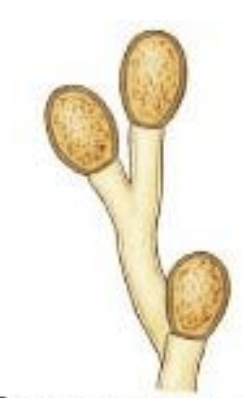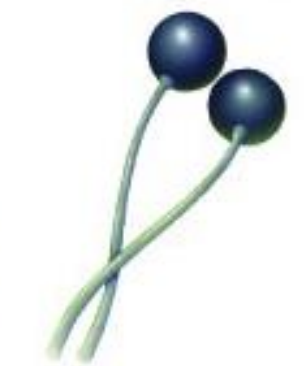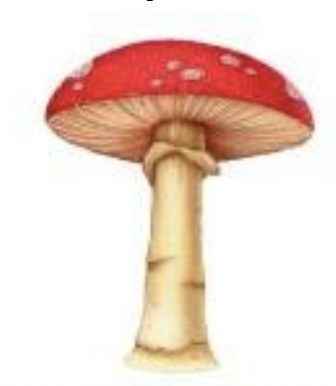Fungal Diversity - lec 1
1/39
Earn XP
Description and Tags
• Introduction • Morphology • Reproduction & Dispersal • Ecological roles: Recyclers, Mutualists, Pathogens, Parasites, and Predators
Name | Mastery | Learn | Test | Matching | Spaced |
|---|
No study sessions yet.
40 Terms
Characteristics of ALL Fungi
Chitin
Heterotrophs
Chitin:
tough and flexible molecule (similar to, but stronger, than cellulose)
Absorptive nutrition- saprobes:
(type of decomposer): absorb nutrients from dead organic matter
mutualists:
gain AND receive nutrients from their partners (fish and sharks)
parasites:
non mutual benefit, absorb nutrients from living hosts (baby and pregnant mother)
Animals eat their food and digest it:
engulf and digest internally and absorb nutrients from the gut.
Fungi live in their food:
externally secrete digestive enzymes and transport products (e.g., sugars, amino acids, peptides) into their cells.
Both fungi and animals are…
heterotrophs: obtain both energy and carbon from consuming (organic) material, but (live in vs eat food)
Plants are
(photo)autotrophic
fungi are
(chemo)heterotrophic
Both fungi and plants have _____, but fungi use _____ instead of cellulose and lignin for support
cell walls, chitin
Fungal Chemotropism
• Most fungi grow towards their food chemotropism (respond to chemical stimuli)
• Grow toward chemicals released by food (e.g., like animals smelling food)
• Growth occurs at the tip, like a root
Single celled form of fungi
unicellular members of several different groups (not always multicellular)
Commonly known as yeast
structural characteristics of multicellular fungi
hypha
mycelium
Hyphae
Composed of tubular filaments
high surface-to-volume ratio for absorbing nutrients
Mycelium
Network of hyphae
a branching network of hyphae and the “fungal body”, like plant roots, used for absorption & structure, but also used in decomposition (unlike plant roots)
has a high surface area-to-volume ratio: good for acquisition of water and nutrients
What we see of fungi is often the ____ (aboveground) (e.g., a mushroom)
“fruiting body”
Fruiting body produces…
spores
Asexual (“without sex”) reproduction:
haploid spores produce haploid hyphae that give rise to more haploid spores (most common)
Sexual reproduction:
fusion of haploid hyphae of different mating types
Why do fungi have "mating types" instead of sexes?
because they are morphologically identical and often have more than two mating types.
Sexual Reproduction - Fusion of two haploid hyphae of different mating types produces
dikaryotic hyphae
Dikaryon:
a cell with two genetically different haploid nuclei (one from each parent hypha)
Syngamy (fertilization) requires two sequences:
1) plasmogamy: fusion of the cytoplasm
2) karyogamy: fusion of the nuclei
Spores can be produced from ______ OR ______
meiosis (sexual reproduction), mitosis (asexual reproduction)
Roles of Fungi: Saprobes
Soil formation
Nutrient recycling
Roles of Fungi: Mycorrhizae
plant roots + fungal hyphae
present in some of the earliest land plants!
Nearly ALL vascular plants have mycorrhizae!!
Mycorrhizae - Fungus
Hyphae penetrates soil around/in plant roots, increasing surface area (more water/minerals/nutrients absorbed).
Mycorrhizae - Plant
Provides carbon compounds (e.g., sugars, amino acids) → products of photosynthesis.
Roles of Fungi: Lichen
fungus + photosynthetic organism (either cyanobacterium, unicellular algae, or both)
First to establish in harsh environments
Sensitive to toxic compounds (indicators of air pollution)
Lichen - Fungus provides
protection, attachment, acquisition of water, minerals.
Lichen - Algae or cyanobacteria provides
carbon compounds (e.g., sugars, amino acids).
Ants depend on
fungus (food), AND bacterium (to control fungus parasite)
Mutualist bacteria controls
parasitic fungus that co-evolved with ant
Fungi: Parasites
• Hyphae invade plant or animal tissue (with enzymes or pressure)
• Grow inside, absorb nutrients
• Often disperse spores outside host (e.g., Cordyceps, a fungal parasite of insects)
Fungi: eukaryotic organisms that are…
more closely related to animals than to plants
Chytridiomycota
“flagellated spore” fungi

Zygomycota
“conjugative” fungi

Basidiomycota
“stalked spore” fungi - spores on a pedestal

Ascomycota
“cup” fungi (& morels) - little sacs “honycomb”
